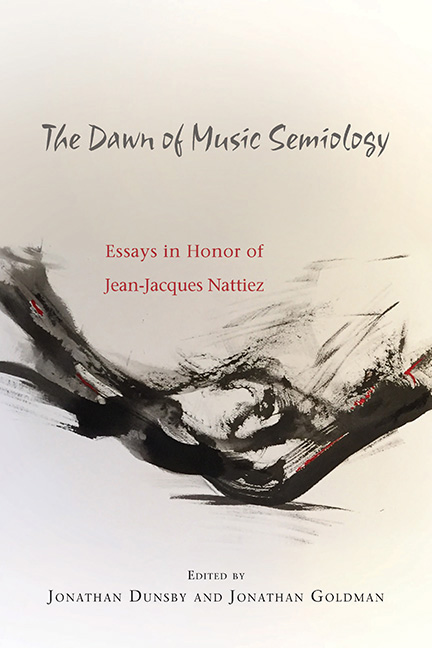Book contents
- Frontmatter
- Contents
- Foreword: About Jean-Jacques Nattiez
- Acknowledgments
- Introduction
- Part One Metaconsiderations
- Part Two Poietic Channels
- 4 From Georgian to Medieval Polyphonies: Analysis and Modeling
- 5 Schenker's Inhalt, Schenkerian Semiotics: A Preliminary Study
- 6 Music under the Sign of Modernism: From Wagner to Boulez, and Britten
- Part Three Esthesic Excursions
- Selected Bibliography of Works by Jean-Jacques Nattiez
- List of Contributors
- Index
- Tabula Gratulatoria
6 - Music under the Sign of Modernism: From Wagner to Boulez, and Britten
from Part Two - Poietic Channels
Published online by Cambridge University Press: 26 April 2018
- Frontmatter
- Contents
- Foreword: About Jean-Jacques Nattiez
- Acknowledgments
- Introduction
- Part One Metaconsiderations
- Part Two Poietic Channels
- 4 From Georgian to Medieval Polyphonies: Analysis and Modeling
- 5 Schenker's Inhalt, Schenkerian Semiotics: A Preliminary Study
- 6 Music under the Sign of Modernism: From Wagner to Boulez, and Britten
- Part Three Esthesic Excursions
- Selected Bibliography of Works by Jean-Jacques Nattiez
- List of Contributors
- Index
- Tabula Gratulatoria
Summary
An Initial Analysis
Benjamin Britten's Tema “Sacher” (1976) is a one-minute, one-page, fourteen- bar composition for solo cello in C minor. It uses two basic types of material, the first presenting two broadly melodic statements of the motif E♭, A, C, and B, the second an edgier moto perpetuo based on just two notes, E and D (ex. 6.1). These are the six pitch classes derived from the surname of Paul Sacher (Es/E♭, A, C, H/B♮, E, Re/D) and reflect the composition's role as part of a seventieth-birthday tribute to Sacher commissioned by Mstislav Rostropovich.
Another product of Rostropovich's commission—a total of twelve composers were involved—was Boulez's Messagesquisse for seven cellos. This also uses the “Sacher” hexachord as its source, but instead of Britten's tonal voice leading, which introduces nonhexachord notes to reinforce a relatively diatonic bass line (for example, C to G in bar 1) and a C–D♭–C cadence at the end, Boulez's pitches are generated from a pair of six-by-six matrices that preserve the order of the Sacher interval classes while systematically supplementing the original six pitch classes through rotation (matrix A) and transposition (matrix B)—procedures that assign a certain priority to E♭, but which nevertheless have more to do with post-tonal serial technique than with tonality (exx. 6.2– 6.3; table 6.1).
Example 6.1. Benjamin Britten, Tema “Sacher” (1976). Reproduced by permission of Faber Music.
Example 6.2. Pierre Boulez, Messagesquisse, ordered and unordered “Sacher” hexachords.
Table 6.1. Boulez, Messagesquisse, derived matrices from the ordered version of the “Sacher” hexachord (Matrix A) by rotation (Matrix B) by transposition.
Example 6.3. Boulez, Messagesquisse, opening of final section, cello 1 only. Pierre Boulez, Messagesquisse | für Violoncello solo und 6 Violoncelli. c Copyright 1977 by Universal Edition (London) Ltd., London/UE 16678.
Boulez's eight-and-a-half-minute score falls into five distinct phases:
1. a recitative-like introduction, separating the first, principal cello from the other six:
2. a much faster, contrapuntal moto perpetuo
3. a return to something more recitative-like, but with the first cello providing fragmentary reminiscences of the moto perpetuo against the sustained trilling of the supporting ensemble
4. a cadenza-like episode for the principal cello with alternating relatively animated and reflective statements
- Type
- Chapter
- Information
- The Dawn of Music SemiologyEssays in Honor of Jean-Jacques Nattiez, pp. 97 - 116Publisher: Boydell & BrewerPrint publication year: 2017



